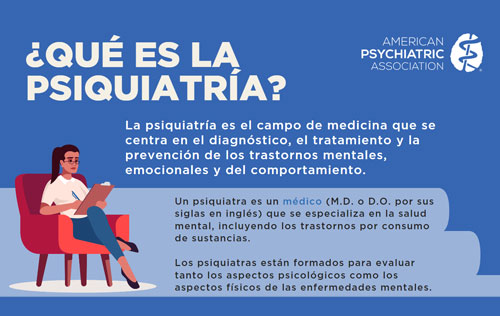APA is engaging in a comprehensive web and social media campaign in both English and Spanish to boost the public’s understanding of psychiatry and what psychiatrists do.
The “What is a psychiatrist?” promos spotlight the rigorous medical training psychiatrists complete, how they differ from psychologists and other mental health professionals, and their varied work settings and subspecialties. Some campaign videos feature vignettes from members of APA’s Council on Communications, explaining why they chose to enter the field of psychiatry.
The goal of the effort—tagged on social media with #Psychiatry101—is to obtain 1 million impressions by May 2025. Since launching in June, the campaign has garnered more than 502,361 total impressions as of Aug. 21 across APA’s social media platforms.
“There’s still a fair amount of confusion about the difference between psychiatrists and psychologists and other mental health professionals,” said Howard Y. Liu, M.D., M.B.A., chair of APA’s Council on Communications and chair of psychiatry at the University of Nebraska Medical Center. “People are surprised to find out, for example, that we also do psychotherapy. I think sometimes the stereotype is that we only dispense medications—which is certainly something we’re proud of and well trained for—but we also do so much more.”
The initiative comes at a critical juncture in psychiatry, as greater demand for psychiatric services is compounding a preexisting clinician shortage. There is also a looming retirement drain: More than 60% of psychiatrists are 55 or older, according to AMA data, and more than one-fifth of psychiatrists are expected to retire in less than a decade.
“We’re not training enough new psychiatrists to make up this shortfall,” Liu said. To help combat this, APA is working to increase the number of graduate medical education (GME) slots for psychiatric residency. There has been some recent success so far, with psychiatry posting the second-biggest gain (26% increase) in the number of first-year residents and fellows from 2016 to 2021, second only to the increase in sports medicine slots, according to the AMA. This caps 12 straight years of increases in the number of accredited slots for psychiatry.
“What Is Psychiatry?” also provides guidance on when a person should seek psychiatric care, the range of treatments psychiatrists provide, and the goals of such care. The Council on Medical Education and Lifelong Learning is also participating in the campaign.
“This effort shows the passion that our members have for their work,” Liu said. “So many have answered the call to tell their story about their work that’s cutting edge or that is fundamentally improving the lives of their patients. Each one of those stories, whether it is about new research or innovative clinical care or outstanding training, makes the case for why psychiatry is essential and should be supported in every state.”
The effort has also involved a refresh of the “What Is Psychiatry?” page on APA’s website as well as the creation of “¿Qué es la psiquiatría?,” a Spanish-language version on APA’s
LaSaludMental.org.
At APA’s 2024 Annual Meeting, members from around the world also recorded videos explaining their day-to-day work in their native language. “It’s really inspiring to see the work that psychiatrists are doing around the world,” Liu said. “It’s exciting to see our story shared.” ■

